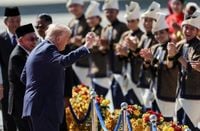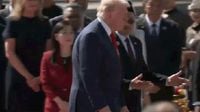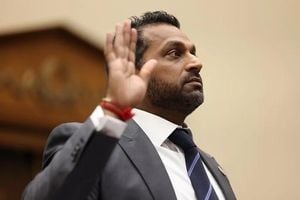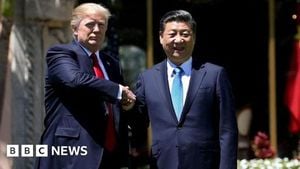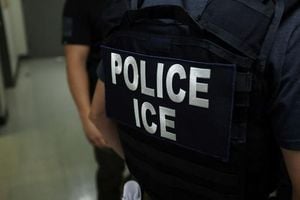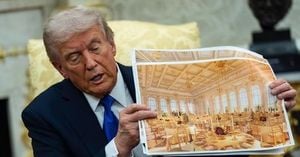When U.S. President Donald Trump stepped onto the tarmac at Kuala Lumpur International Airport on October 26, 2025, few could have predicted that his signature fist-pump dance would become the talk of the town. Yet, as he greeted a troupe of Malaysian performers, Trump’s now-famous moves—dubbed by the White House as the “TRUMP DANCE MALAYSIA VERSION”—set a surprisingly lighthearted tone for what was, in reality, a high-stakes diplomatic mission across Asia.
Trump’s arrival marked the kickoff of a five-day tour through the region, with Malaysia as the first stop. According to The Associated Press, the president’s dance was met with cheers from local performers and signaled his readiness to engage with the leaders of the Association of Southeast Asian Nations (ASEAN) at their 47th annual summit in Kuala Lumpur. Malaysian Prime Minister Anwar Ibrahim had orchestrated a vibrant welcome, blending cultural tradition with political theater.
But beneath the spectacle, the trip carried significant diplomatic weight. Trump was in town not just for photo ops, but to help broker a rare peace agreement between two neighboring ASEAN members, Cambodia and Thailand. According to Fox News, the ceasefire agreement—signed in Trump’s presence at the summit—required Thailand to release 18 Cambodian soldiers held prisoner and for both countries to begin removing heavy weapons from their shared border. Cambodian Prime Minister Hun Manet called it a “historic day,” while Thai Prime Minister Anutin Charnvirakul said the deal laid “the building blocks for a lasting peace.”
Trump, never one to shy away from self-congratulation, declared, “We did something that a lot of people said couldn’t be done.” His remarks, reported by Fox News, underscored the skepticism that had surrounded the negotiations. Malaysian Prime Minister Ibrahim also praised the agreement during his summit opening remarks, noting that “it reminds us that reconciliation is not concession, but an act of courage.”
The peace deal wasn’t the only major development. Trump quickly pivoted to economic diplomacy, reaching separate trade agreements with both Cambodia and Thailand. These deals, as reported by Fox News and Reuters, were designed to bolster U.S. ties in the region and, crucially, to help the United States diversify supply chains away from an increasingly assertive China. In that same spirit, Trump also signed agreements with Malaysia focused on trade and critical minerals—an area of growing strategic importance as Beijing continues to limit exports of key technology components.
While Trump’s dance steps and diplomatic wins made headlines in Asia, back home his trip was stirring controversy. As USA TODAY highlighted, the president’s travels coincided with a grinding fourth week of a U.S. federal government shutdown. The deadlock, rooted in a dispute over Affordable Care Act subsidies, threatened to disrupt SNAP and WIC funding for around 42 million Americans starting November 1, 2025. Congressional Democrats, including Senator Chuck Schumer of New York, argued that Trump should have remained in Washington to help resolve the crisis. “Shouldn't the president listen to the cares of the American people and their desperate need on health care, rather than taking a foreign trip?” Schumer asked, reflecting the frustration among many lawmakers.
The stakes of the shutdown were high. At its core was a disagreement over whether to permanently extend enhanced tax credits for health insurance—credits that expanded eligibility to those making more than four times the federal poverty level (in 2025, $62,600 for an individual or $124,800 for a family of four). If Congress failed to act by year’s end, premiums could rise by more than 75% on average, according to USA TODAY. Republicans, for their part, insisted they would not discuss health policy as part of a bill to reopen the government, while Democrats saw the extension as urgent, with open enrollment for state health insurance marketplaces looming on November 1.
Yet, in Kuala Lumpur, the focus remained on international affairs. Trump’s Asia tour was packed with high-level meetings, including sessions with newly-elected Japanese Prime Minister Sanae Takaichi in Tokyo and, later, a much-anticipated encounter with Chinese President Xi Jinping in South Korea. The White House made it clear that trade was at the top of the agenda. On October 20, just days before departing, Trump expressed optimism about a potential deal with China, telling reporters, “I think we’ll make a deal. They threatened us with rare earths, and I threatened them with tariffs.”
Behind the scenes, U.S. Treasury Secretary Scott Bessent and Trade Representative Jamieson Greer were hard at work. As Reuters reported, they met with Chinese Vice Premier He Lifeng and top trade negotiator Li Chenggang on the sidelines of the ASEAN summit in Kuala Lumpur. This marked the fifth round of in-person discussions between the two sides since May. The talks covered a wide range of issues: trade expansion, the extension of the current truce, fentanyl, U.S. port entrance fees, rare earths, and even the fate of TikTok. Bessent described the negotiations as “very substantial,” while Li called them “candid.” Bessent added, “I think we have a very successful framework for the leaders to discuss on Thursday.”
Trump’s itinerary was ambitious. After Malaysia and Japan, he was set to travel to South Korea for his October 30 meeting with Xi Jinping. The possibility of a breakthrough trade agreement loomed large, but Trump was careful not to overpromise. As USA TODAY noted, the president said he might leave Asia without a deal if the terms weren’t right, keeping both allies and rivals guessing about the outcome.
The White House, meanwhile, leaned into the lighter side of the trip, sharing videos and images of Trump’s dance moves on social media. The president’s performance—part campaign trademark, part diplomatic icebreaker—seemed designed to humanize him on the world stage and perhaps distract from the political storm brewing back home.
For many observers, the juxtaposition was striking: a president dancing in Malaysia while millions of Americans faced uncertainty due to the shutdown. Yet, as the ASEAN summit unfolded, Trump’s blend of showmanship and deal-making left its mark. Whether the ceasefire between Cambodia and Thailand will hold, or if the trade talks with China will yield results, remains to be seen. But for one weekend in Kuala Lumpur, the world’s attention was firmly fixed on a U.S. president who, for better or worse, knows how to command a stage.
